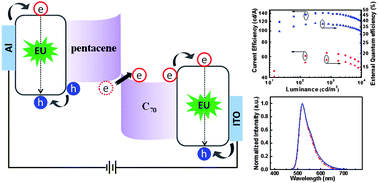Charge generation mechanism of tandem organic light emitting diodes with pentacene/C70 organic heterojunction as the connecting layer
Abstract
The working mechanism of a planar organic heterojunction based on pentacene/C70 under reverse voltage is studied through current–voltage (I–V) and capacitance–voltage (C–V) measurements. It is found that the pentacene/C70 heterojunction generates large amounts of charges and the charge generation is a tunneling process. The proposed Fowler–Nordheim (F–N) model theoretically demonstrates the I–V properties of the pentacene/C70 heterojunction-based device at different temperatures. The heterojunction interface energy diagram is also well determined by ultraviolet photoemission spectroscopy (UPS) measurements, further elucidating this tunneling process. Moreover, by taking advantage of the large charge generation property of the pentacene/C70 heterojunction, a high efficiency green tandem organic light emitting diode (OLED) is successfully fabricated, where not only the current efficiency is doubled, but also the power efficiency is greatly enhanced, proving the excellent performance of the pentacene/C70 heterojunction as charge generation layer (CGL). This work highlights the working mechanism of such heterojunction and provides us a new guide to design high performance tandem OLEDs.


 Please wait while we load your content...
Please wait while we load your content...